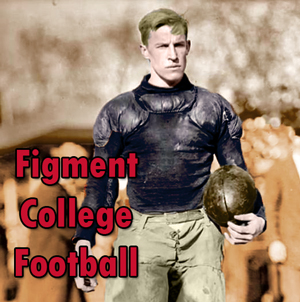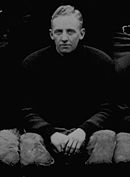1908 YEAR-IN-REVIEW
Football in 1908 was still very much a sport in flux. The "safety" measures put in after the 1905 season had made some in-roads, but there were still eleven fatalities on the gridirons of America in 1908: nine among high schoolers and two others at the collegiate level (one at Cowpens State and the other at St. Matthew's College). The forward pass rule was modified - a bit - to counteract a strategy put in place by Noble Jones College coach John Christian. The Colonels' QB (Tommy Stevenson) would throw the ball high in the air and hope one of his team mates would pull it out of the resulting scrum before it hit the ground. To counteract this, the AIAA modified the rule saying that if a second player from the passing team touched the ball, the ball would be given to the defense at the spot of the "illegal touching." Christian grumbled and said some un-Christian things before going back to the chalkboard to design a new strategy.
Only two squads would manage to go unbeaten in 1908 - the St. Andrews Barons and Empire State Centurions. The Tennessee-based Barons had become a surprise power in the sport joining other schools such as Opelika State, Bayou State, Noble Jones and Central Carolina in a bloc of southern powers to counteract the heavily-Eastern balance of power in college football. There were four main areas of prominence in the sport at this time: the ivy-drenched "Old Line" schools sich as Ellery, Dickson, George Fox and Sadler (the teams that would form the Academia Alliance eventually), the Pennsylvania powers such as Liberty College, Centerville, Henrietta, and Penn Catholic, the Midwestern powers like Chicago Poly, Laclede, Detroit City and up & coming Central Ohio and the aforementioned southern schools. The West was emerging and would soon feature its own national powers, but for now, the heart of college football remained, largely in the Northeast - especially in the minds of the public. Empire State, a non-Academia school, was fighting for recognition amongst the traditional eastern powers.
What the Academia schools despised most was the success of Centerville. The Chiefs had seemingly come from nowhere to arguably become the nation's top squad and the bluebloods resented and belittled the "Indian school" as overachievers. Centerville coach Pug Johnston had played at Sadler, and this rankled his alma mater, particularly since Pug demanded that his squad be respected. So it was a bit of a surprise when the 1908 schedule featured a November 7th match between Centerville and the Dickson Maroons. Johnston had raised his program's profile and was confident enough to schedule not only Dickson (he was denied by Sadler, Ellery & Fox - and Brunswick failed to respond to his letter), but also strong non-Academia squads like Annapolis Maritime, Laclede, St. Pancras and the College of Omaha while also taking on fellow Pennsylvania powers like Penn Catholic and Liberty College. Johnston played more games than anyone else and he set his sights high. He was also a brilliant coach and strategist.
Without the now-graduated Alfred Trumaine (of whom we'll hear more later), the Chiefs were expected to take a step back in 1908. And they did... by losing one of their thirteen contests to finish 12-1-0. The lone loss came to Liberty College in Philadelphia, in a game dubbed the "Battle for Pennsylvania" on a windy day that saw both schools miss every attempted kick in what turned out to be an 18-6 victory for the Bells. Other than that, Trumaine or not, they won every game. St. Pancras fell 28-0; Annapolis Maritime played great defense and still lost 13-0; Dickson managed to score - a field goal - in a 17-3 loss; Minnesota Tech fell 20-0 in a snowstorm in St. Paul; Laclede got lassoed 38-7; the College of Omaha was wiped out 29-0 and Mile High State finished the season for both schools on December 5th with a 23-0 loss. On the season, Pug's charges scored 343 points and allowed only 28.
It was a good year for the Keystone State's colleges: Centerville's strong showing topped the list, but Liberty College went 8-2-0 while Penn Catcholic went 6-1-0 and George Fox went 6-1-2. Ellery had the strongest showing for the Old Line schools, posting a 6-1-2 ledger for the season with star back Merritt Spaulding being generally considered the top player in the nation. Sadler, coming off a strong campaign in 1907, fell back to the pack with a 5-5 campaign. Bayou State's 9-1-0 season topped the southern schools while Potomac College posted a surprisingly solid 9-1-0 season.
In its 1936 "Retroactive Championship Review" the Omni Sports Bureau designated St. Andrews as its national champion for 1908, with Bureau head Thomas Potentas noting that the Centerville's loss to Liberty "severely handicapped any chance of the Chiefs being recognized as champions despite their otherwise outstanding record." With Centerville's closure in 1918, there was no organization willing to counter Potentas' decision (though Empire State noted that it too had been unbeaten in 1908).
Mott's All-American Team for 1908:
Backs
- Merritt Spaulding, Ellery (SR)
- Noel Combs, Empire State (SR)
- Leopold Cobbs, Central Carolina (JR)
Ends
- Norman Trotter, St. Andrews (SR)
- Avery Caudill, Henrietta (SR)
- Milo Beaulieu, Bayou State (SR)
Linemen
- Everett Witcher, Opelika State (SR)
- James Shively, Bluegrass State (SR)
- Merle Bradbury, Frankford State (SR)
- Emerson Garner, Penn Catholic (SR)
- Homer Winston, Chicago Poly (SR)

